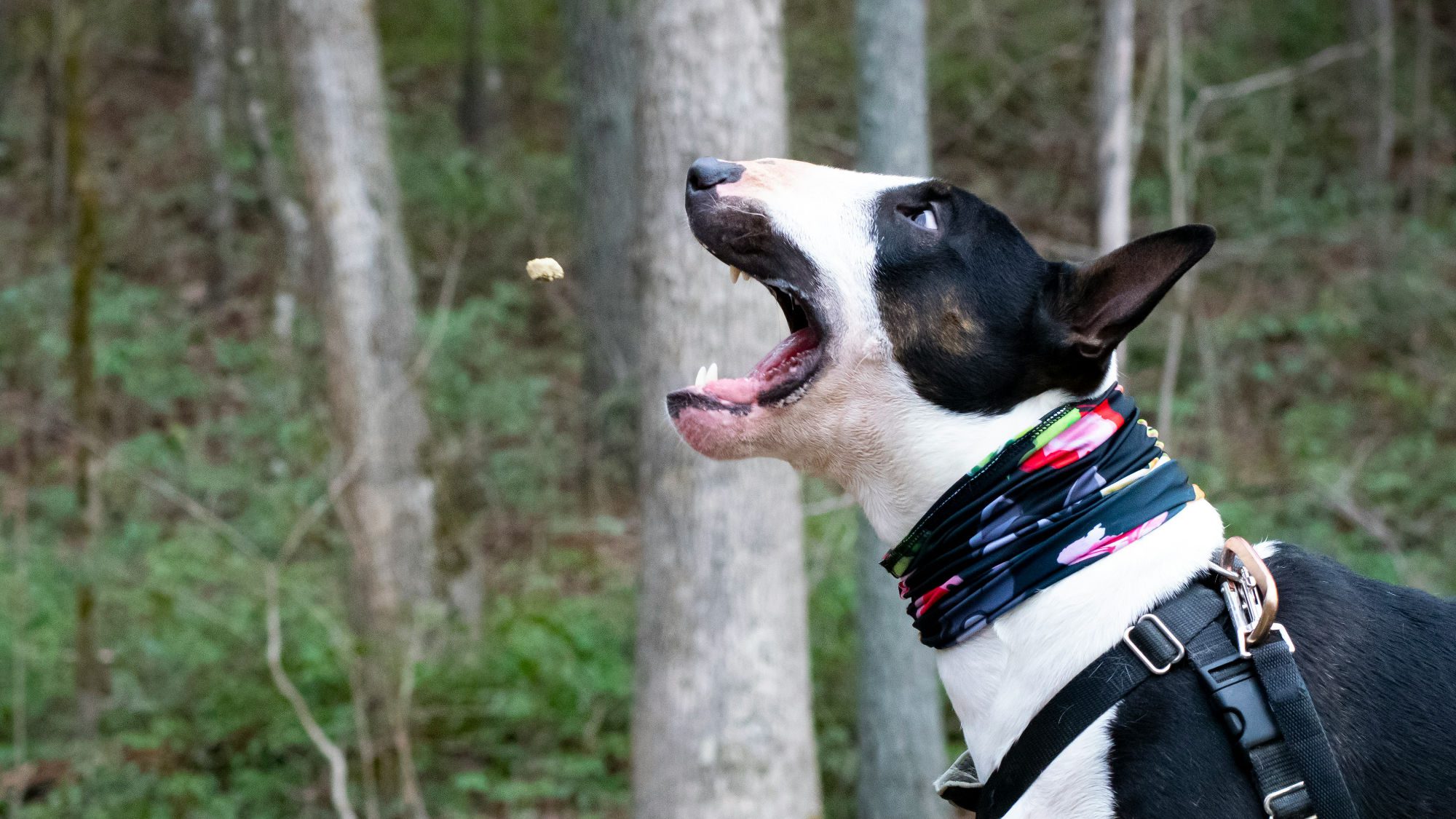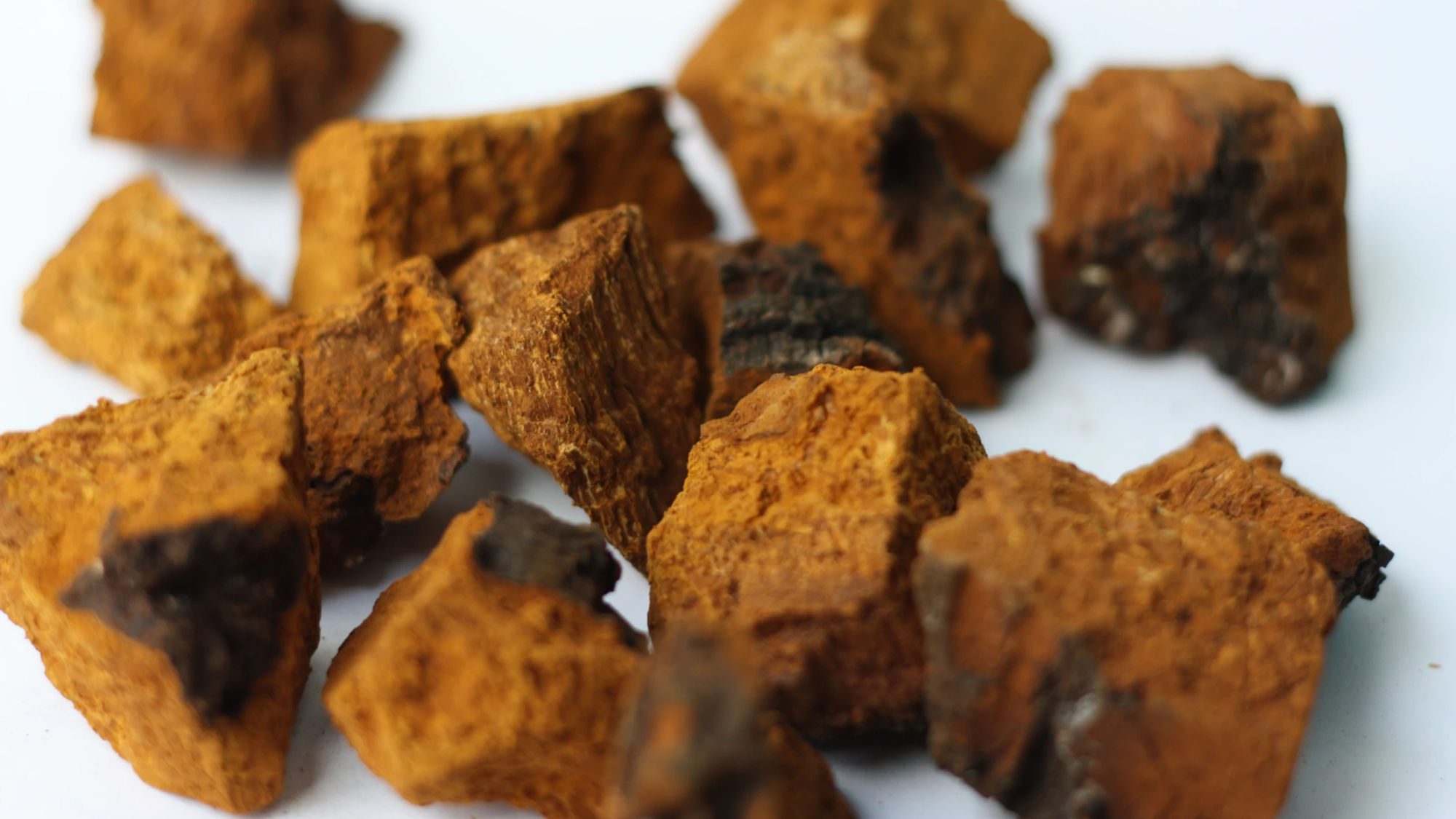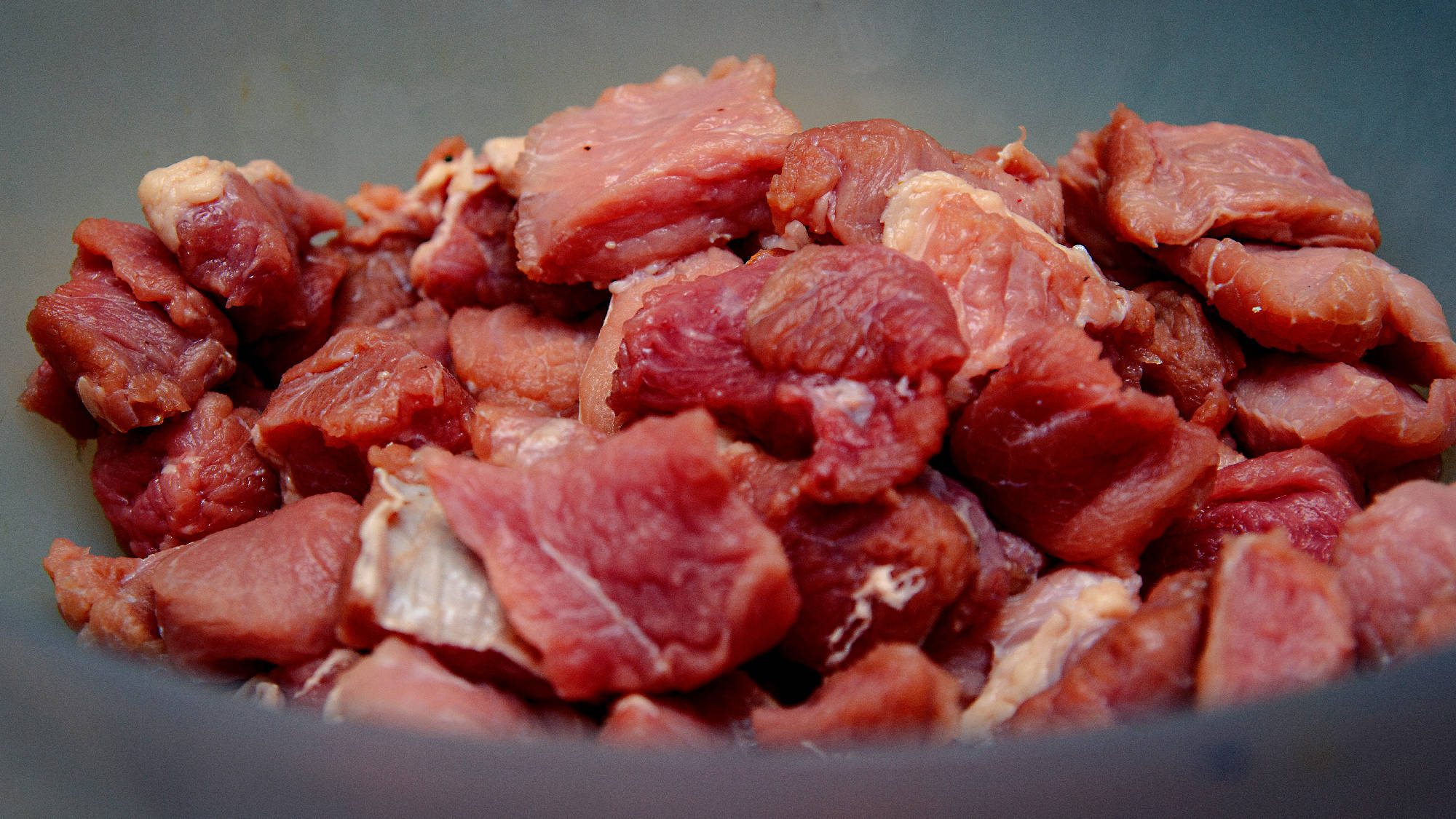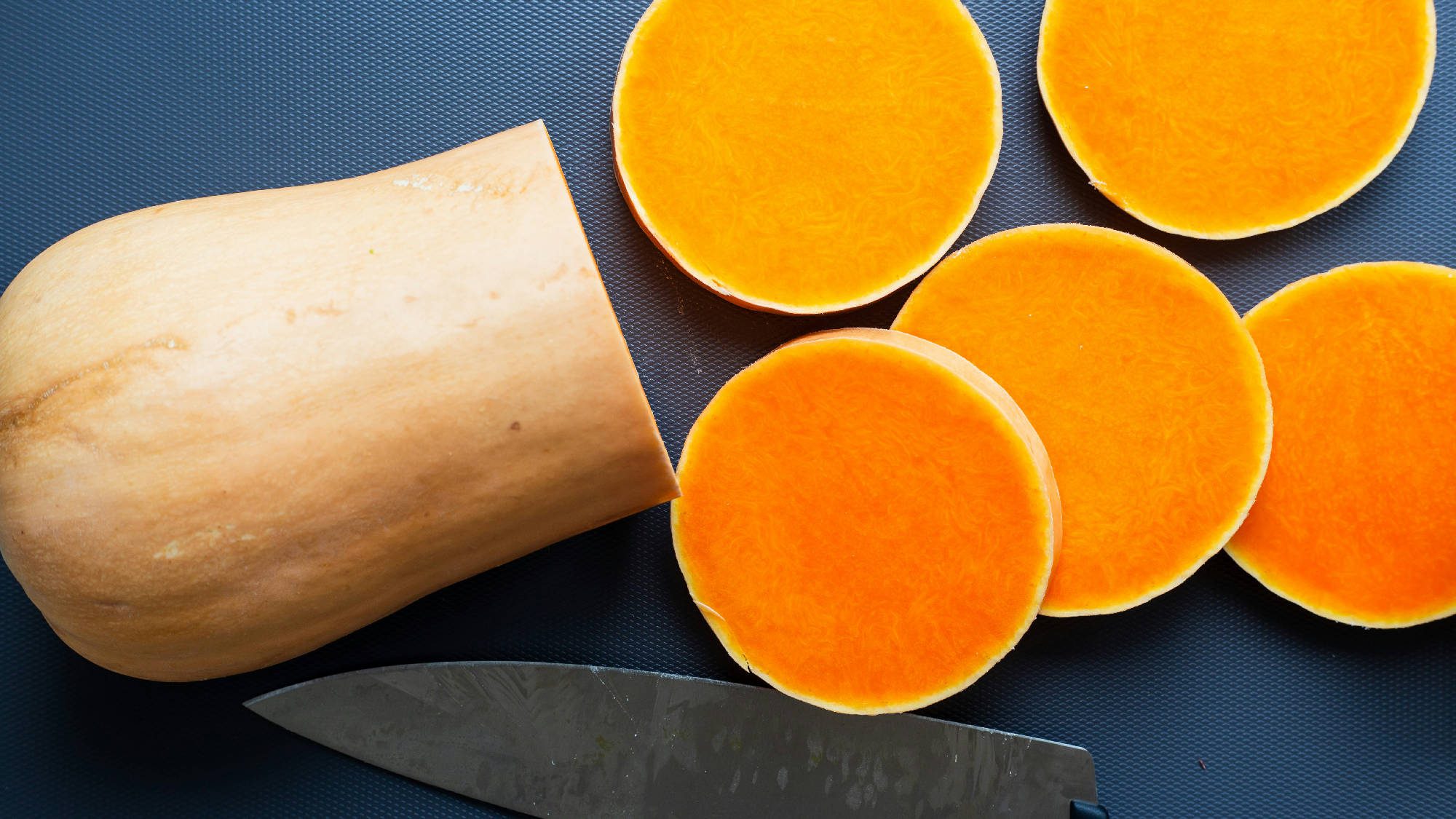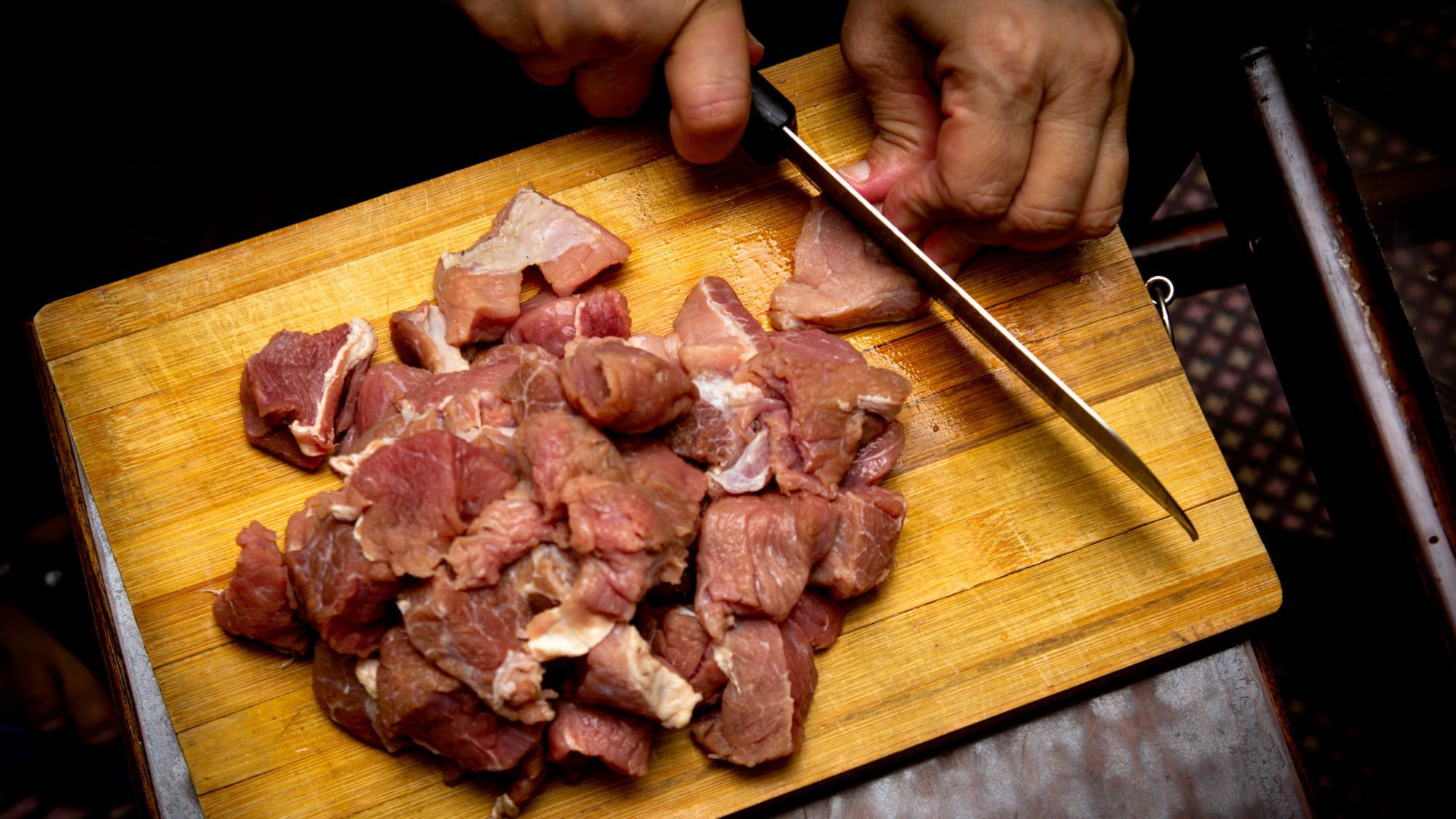I’ve been feeding my dogs a raw diet for over twenty years now. Over those twenty years, I’ve learned a lot … and the raw diet I feed my dogs today has changed from the raw diet I fed them twenty and even five years ago. One of the most significant changes to my dogs’ raw meals is the absence of chicken and other poultry. When I started out feeding raw, I used to love that chicken was inexpensive and easy to get … but today I think it’s better to skip the chicken altogether and splurge on other meats instead.
Why? Because feeding chicken and most other poultry creates two very significant nutritional problems that can cause health issues in dogs.
I know that’s a controversial statement, but before you start worrying about the cost of cutting chicken out of your dog’s raw diet, just hang in there … I’m going to first tell you why I no longer feed chicken but I’ll also show you some workarounds to make poultry less costly to your dog’s health.
Table of Contents
- Nutritional Pitfalls of Chicken — You Are What Your Food Eats
- The Problem With Omega-6 Fatty Acids
- Chicken is High in Omega 6
- Can Your Dog Eat Chicken And Be Healthy?
- What is a Healthy Omega 3 to 6 Ratio?
- How Much Vitamin D is In Chicken?
- Dogs Need Vitamin D
- Making Chicken (And Pork) Safer For Your Dog
- Making Informed Protein Choices for Your Dog’s Well-being
Nutritional Pitfalls of Chicken — You Are What Your Food Eats
What makes chicken different from other protein sources?
If it’s true that you are what you eat, the diet that’s fed to chickens is essentially what you’re feeding your dog — whatever the chicken eats, good or bad, is what your dog eats. The chicken is just the middleman. And the chicken’s diet is deplorable.
Here’s an ingredient label from a popular commercial chicken feed:
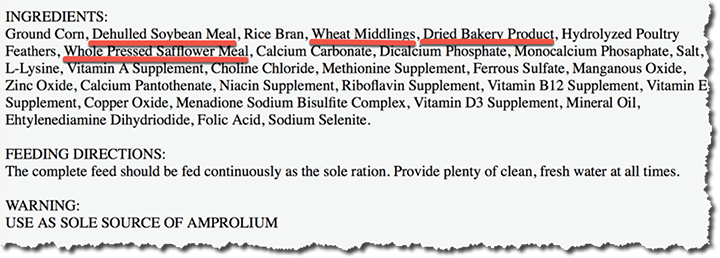
You can see the base of the diet is leftovers from plants after we humans process then and take all of the oils out. And if you’re wondering what dried bakery product is, it’s a mixture of bread, cookies, cake, crackers and flour – which are just waste from human food manufacturing.
Because the base ingredients are just waste and hold little nutritional value for the chicken, the feed needs to be supplemented with synthetic vitamins and minerals, as well as free amino acids. The waste products that make up the bulk of the feed provide calories and little else, so free amino acids, mineral oil and synthetic vitamins and minerals need to be added into the chicken feed to make it food-like.
Now, believe it or not, chickens aren’t supposed to be eating things like cereal, white bread and donuts … even when they’re fortified with vitamins and minerals. And when they do, it spells big trouble for the dog eating those chickens …
The Problem With Omega-6 Fatty Acids
Here’s the deal … we humans love foods that are high in something called omega-6 fatty acids. That’s because we love snacks and processed foods made with plant oils such as soy, corn and sunflower oils (which are really high in omega-6 fats). And the waste from all of those oils gets ground up and put into chicken feed.
Omega-6 fatty acids have the ability to make hormones in your dog. So does its antagonistic brother, omega-3 fatty acid. But the hormones they each produce have very different jobs.
The omega-6 fatty acids produce hormones that increase inflammation, which is an important part of your dog’s immune response. The hormones produced by omega-3 fatty acids work antagonistically and decrease that inflammation. So a balance between these hormones, and the fatty acids that control them, plays a large role in your dog’s immune system and overall health.
Not surprisingly, birds in the wild don’t eat corn or soybeans. They live on grasses and insects. And as you can see, there’s a huge difference between the natural grasses and bugs the chicken is supposed to eat and the corn and soy waste products he’s forced to eat:
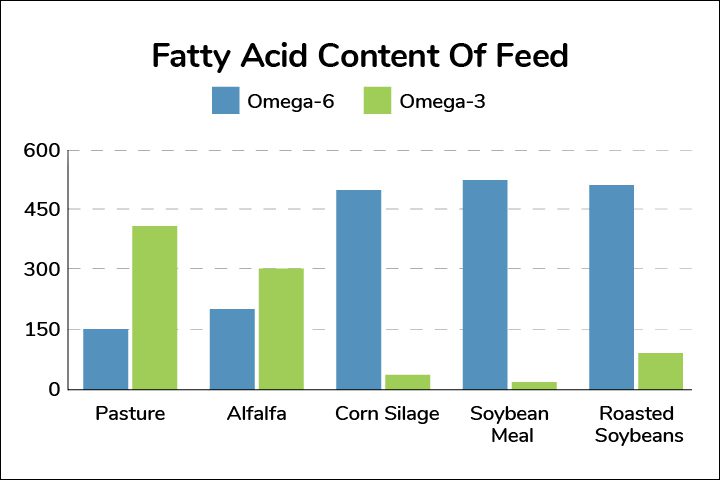
While the foods the chicken is supposed to eat contain more omega-3 than omega-6 fatty acids, corn and soy contain ten times more omega-6 fatty acids. And this fundamentally changes the chicken … it makes the chicken high in omega-6 fatty acids because the chicken is what he eats.
The same applies to your dog. If you feed your dog that omega-6 rich chicken, he’ll get the exact same omega fatty acid imbalance the chicken had. You are what you eat.
And your dog won’t be in very good shape if he eats that chicken. Nearly every chronic disease, from allergies and joint pain to diabetes and kidney disease, is caused by chronic inflammation. And chronic inflammation is caused by a diet that’s high in omega-6 fatty acids and low in omega-3 fatty acids.
Are you starting to see why I don’t feed my dogs chicken? Chicken (and any other poultry) contains the highest amount of omega-6 fatty acids … by a landslide! Let’s take a closer look.
Chicken is High in Omega 6
I don’t want to sound too alarmist — but chicken fat is unbalanced! Chicken fat is so unbalanced that it will cause chronic inflammation in your dog, and he’ll never be able to eat enough healthy food to recover from it.
I want to show you why I’m so adamant about not feeding chicken. Let’s compare chicken to other meats you might feed your dog. And remember, we want to balance the amount of omega-6 and omega-3 fatty acids to avoid chronic inflammation.
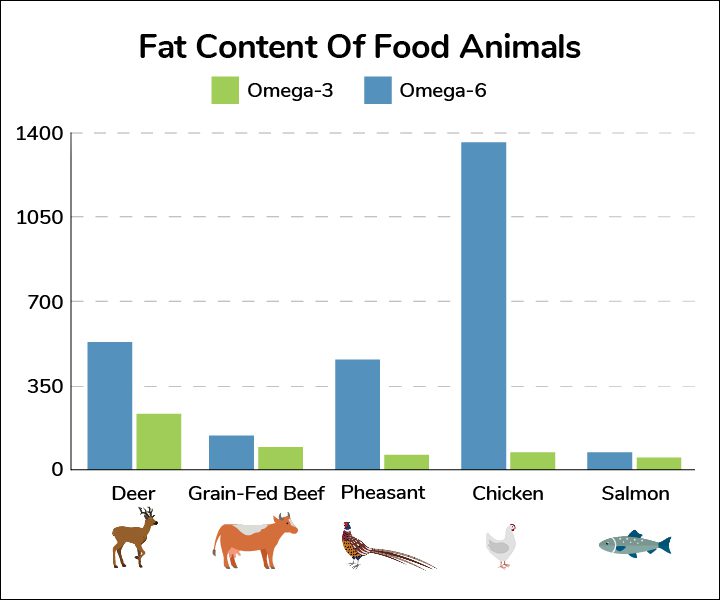
Here’s a comparison of the omega-6 and omega-3 fatty acid content in some common foods you might feed your dog, plus some of their wild cousins. See anything out of place?
While all the other animals are reasonably balanced in their fatty acids, chicken is way out of whack. It’s so messed up, it’s not even in the same zip code as the other meats. And that’s because of the foods we feed them.
Now you might be thinking “Yes, but beef is also fed grain and waste products. Why isn’t beef as high in omega-6 fats?” Good question! The answer is, cattle, lambs and goats eat grass and hay for most of their lives and are only fed grains for the last few weeks of their lives. But chicken, turkey, duck and other poultry are fed those omega-6 rich foods every day for their entire life. The longer an animal is fed omega-6 rich foods, the worse off he is. Check out this table …
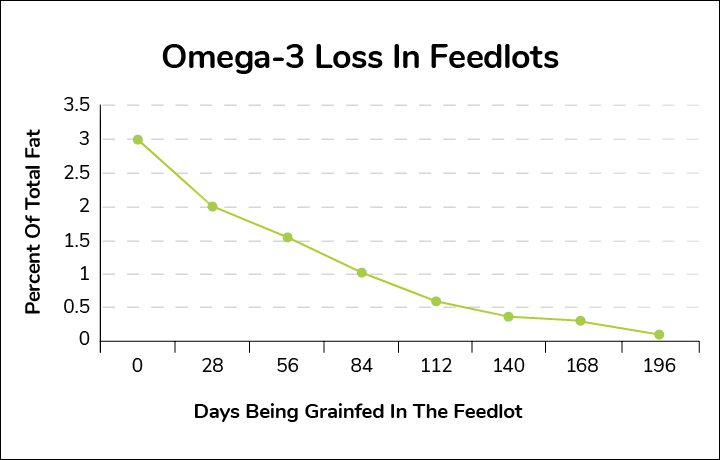
Cite: Duckett, SK et al, Effects of time on feed on beef nutrient composition. J Anim Sci. 1993 Aug;71(8):2079-88.
This shows how feeding corn, soy and other waste grains to feedlot cattle depletes their omega-3 supplies … and the longer the animal eats them, the more he’s robbed of his valuable omega-3 supplies. And to top it off, his omega-6 supplies increase.

If you take a cow and start feeding him corn, soy and other foods high in omega-6 fatty acids, even for just a few weeks, it changes the cow. That cow will soon start to suffer from chronic inflammation because he has too much omega-6 fatty acid in his diet and not enough omega-3 fatty acid in his diet to produce the hormones that lower that inflammation.
Now imagine the chicken, duck or turkey that’s force to eat nothing but soy and corn (and Krispy Kremes and HoHos) for his entire life. It demolishes his balance of omega fatty acids. While the grain-fed cow has about 5 times as much omega-6 than omega-3, the poor chicken averages about 20 times more omega-6 than omega-3.
That chronically inflamed, omega-6 filled chicken only got that way because of the food he was eating. Now think what happens when you feed that chicken to your dog …
Can Your Dog Eat Chicken And Be Healthy?
Honestly, I don’t think your dog can eat a large amount of chicken on a regular basis and not suffer from chronic inflammation. There aren’t any foods that are high enough in omega-3 fats to fix the imbalance … it’s just too high! Look at this …
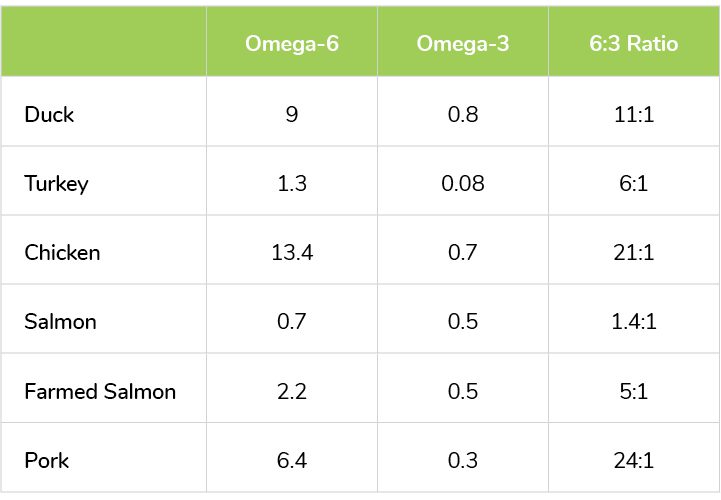
Chicken is so high in omega-6 fatty acids that you can’t feed it and hope to get a reasonably healthy balance of fats. Even if you feed a lot of omega-3 rich fish, let’s say half of your dog’s diet, you’ll still end up with 11 times more omega-6 fatty acids than omega-3.
What is a Healthy Omega 3 to 6 Ratio?
A healthy ratio of omega-6 to omega-3 should be really no more than 5:1.
So if you feed more than a small amount of chicken or duck, which means more than a quarter of your dog’s diet, you’ll never be able to get your dog’s hormones and inflammation under control. You can’t feed chicken as a major part of your dog’s diet and expect really good health and a properly functioning immune system.
But there’s two other things I want you to look at in that table.
Pork is just as bad as chicken … there’s 24 times as much omega-6 in pigs than omega-3. And that’s because pigs are raised and fed the same way.
Turkey isn’t that bad! While chicken and duck suffer some pretty significant increases in omega-6 content, the turkey seems to be more immune to his crappy, grain-filled diet. The omega fatty acid balance in turkey is much more reasonable with only 6 times more omega-6 than omega-3. It’s still a bit high, but you can balance that out with a little fish, rabbit or grass-fed beef.
So how the animal is raised and the foods that he eats can significantly impact the nutrition it gives your dog. And how chickens are raised presents one more nutritional challenge for your dog.
How Much Vitamin D is In Chicken?
No Sun = No Vitamin D
Have you ever seen a pasture full of cows while you were out for a drive? Of course you have! You’ve probably also seen sheep or goats. But what about a pasture full of chickens? You’ve probably never seen one because chickens and other poultry are raised indoors in large buildings (and pigs are too).
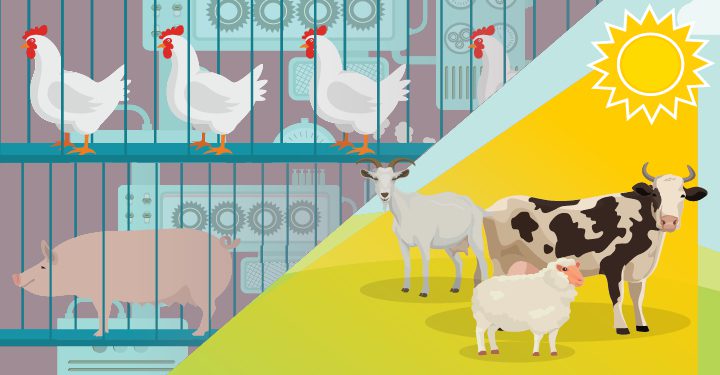
While the building keeps predators from getting in, it also prevents something else from getting in … sunshine!
Your dog was built to eat other animals … his pointy teeth and short digestive tract show us this. Another physiological status that tells us he’s a carnivore is his lack of ability to produce his own vitamin D.
Dogs Need Vitamin D
Vitamin D is critical to your dog’s health. It prevents skeletal deformities in growing puppies, helps regulate the immune system to control inflammatory diseases (just like omega fatty acids do), helps to prevent cancer and contributes to skin health. Without vitamin D, your dog would be a bit of a mess!
Because your dog can’t manufacture vitamin D, he relies on eating animals that can. Unlike dogs, animals like cows, chickens and other herbivorous animals can manufacture vitamin D from sunshine. And there will be lots of it in their skin, liver and kidneys, where it’s manufactured.
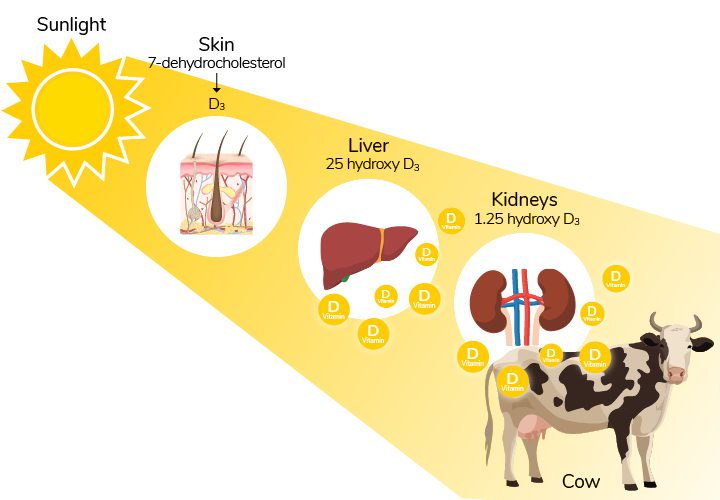
But if your dog is eating animals raised indoors and not in sunlight, those animals will be vitamin D deficient … and your dog will be vitamin D deficient too. If he’s eating a commercial diet, they’ll put some synthetic vitamin D into the food to compensate for this … but if you’re feeding your dog a raw diet that contains a lot of poultry or pork, you need to know he’ll be vitamin D deficient (unless you add some vitamin D to his diet).
Remember, your dog relies on other animals for his vitamin D … if those animals are raised indoors, he’s in trouble and may start to show the symptoms of vitamin D deficiency. And that’s the second reason I no longer feed my dogs chicken.
But with that said, you can add enough vitamin D to your dog’s diet to make up for the lack of it in poultry and pork products. So let’s look at what you can do to boost the vitamin D and the omega-3 content of your dog’s diet if you’re feeding poultry.
Making Chicken (And Pork) Safer For Your Dog
I don’t want to be all doom and gloom … especially when poultry and pork can be the most cost effective parts of your dog’s raw diet! But if you’re going to feed them, you need to know the nutritional holes they create … and how to fix them! So let’s take a look at how we can do that.
Adding Vitamin D
It’s pretty easy to replace the lost vitamin D in your dog’s diet … as long as your dog can tolerate fish. Fish is an excellent source of vitamin D … and unless you’re going to give your dog synthetic vitamin D pills (hint: you really don’t want to do this), fish is really the only way you can salvage your dog’s raw diet if it contains a lot of pork or poultry.
Fish (especially fish liver) is very high in vitamin D, and if you feed about 5 to 10% of your raw diet as fish, you can give your dog enough vitamin D to make up for the lack of it in your pork or poultry diet.
And fish will help with something else …
Adding Omega-3 Fatty Acids
Any diet with more than a small amount of chicken, poultry or pork (with the exception of turkey) will have waaaay too much pro-inflammatory omega-6 fatty acids (and will also be too high in polyunsaturated fats). This is a much trickier problem to solve than vitamin D.
Ideally, you don’t want much more than 5 times more omega-6 fatty acids than omega-3 fatty acids … but chicken, poultry and pork can contain up to 30 times more and average about 20:1). And as I mentioned before, you just can’t climb back out of this hole. So what can you do?
- Feed chickens raised on a proper diet. Feeding organic, free-range chickens will help. They’ll be fed a food that’s more rich in omega-3 fats and this will in turn make the chicken richer in omega-3 fats. Free ranging chickens may also have access to sunshine and that will help solve your vitamin D problem too (although most free range chickens never see the sun).
- Replace your chicken with turkey. Although turkey can be a bit more expensive than chicken, its fats are much better balanced and you’re much less likely to cause chronic inflammation in your dog.
- Skip the chicken and pork. This is the most expensive option and it’s the one I’ve chosen for my own dogs. I do give a small amount of organic poultry a few times a month to increase the polyunsaturated fats (beef, goat and lamb are high in saturated fats and low in polyunsaturated fats), but the mainstay of my dogs’ raw diet is animals raised outdoors and on grass. This is the closest I can get to their primordial diet and, since I can swing it financially, this is what I do.
Add fish (but not fish oil). You can add fish to your dog’s diet if he eats a lot of chicken, duck or pork, but it will never get you into the healthy range. It’s better, but it won’t get you all the way. If that’s your only option, then use it … feed fish several times a week to try to get those fats and hormones as balanced as you can afford. But if you can afford to replace the pork and poultry with beef, rabbit, lamb, deer or other hoofed animals, your dog’s diet will be much less inflammatory. Notice I said fish but no fish oil? Fish oil is just too high in polyunsaturated fats to add to chicken so it’s best to skip it. Plus it’s a processed oil and goes rancid … and you’re feeding a raw diet to avoid processed and toxic ingredients, right?
Making Informed Protein Choices for Your Dog’s Well-being
Shifting away from chicken in your dog’s raw diet might seem daunting initially, but it’s a change that can significantly impact their health for the better. The high levels of omega-6 fatty acids in chicken, coupled with the lack of vitamin D from poultry raised indoors, can contribute to chronic inflammation and other health issues.
By exploring alternatives like organic, free-range turkey or incorporating more fish into their diet, you can address these nutritional gaps. Opting for meats raised outdoors or on grass mirrors a more natural diet for dogs and can help avoid the pitfalls of conventional poultry.
The goal is to nourish your dog with a balanced, healthful diet that supports their well-being at every stage of life, making thoughtful choices about their protein sources is a crucial step in that direction.



